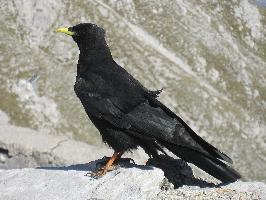
Súlyok és méretek
| Hossz | 42 cm |
|---|
Állatleírás
The House Crow (Corvus splendens), also known as the Indian, Greynecked, Ceylon or Colombo Crow, is a common bird of the crow family that is of Asian origin but now found in various parts of the world. This medium-sized crow is distinguished by its sleek black body with a grey neck and breast, which gives it a rather distinguished appearance amidst the predominantly black plumage of its relatives. Adults typically measure between 39 to 44 cm in length, making them slightly smaller than some of their crow cousins.The House Crow has a highly adaptive nature and omnivorous diet, which allows it to thrive in a wide range of habitats. Although it is originally native to the Indian subcontinent and parts of Southeast Asia, its versatility in scavenging for food has enabled it to spread to many parts of the world, including the Middle East, East Africa, and recently spotted in parts of Western Europe and islands in the Indian Ocean. This expansion is largely due to its stowaway tendencies on ships, leading to new colonies in distant lands.
In terms of behavior, the House Crow is known for its intelligence and resourcefulness. Like other members of the corvid family, it demonstrates remarkable problem-solving skills, which it applies in its search for food and nesting materials. It is highly opportunistic, feeding on a wide range of items from human waste and discarded food to small mammals, birds, and insects. Its diet flexibility is a key factor in its successful adaptation to urban environments, where food sources are plentiful but varied.
The social structure of House Crows is quite fascinating. They are known to form large communal roosts, sometimes comprising thousands of individuals, which serve as centers for social interaction, information exchange, and mating. During the day, they disperse in search of food, often utilizing their keen memory to return to plentiful feeding sites.
Breeding behavior of House Crows involves monogamous pairs that build nests in tall trees or on man-made structures. The female typically lays 3-5 eggs, which she incubates for about 18 days until hatching. Both parents are involved in feeding the chicks, which fledge approximately 4 weeks after hatching. This communal effort in raising the young showcases the species' complex social bonds.
However, the success and adaptability of the House Crow have not been without ecological consequences. In areas where it has been introduced, it often becomes a dominant species, outcompeting native birds and small mammals for resources. Its role as both a scavenger and predator can significantly impact local biodiversity, leading to calls for management and control measures in some regions.
In conclusion, the House Crow is a remarkable example of adaptability and intelligence among birds. Its ability to thrive in human-altered landscapes has facilitated its spread across continents, demonstrating both the resilience and the potential ecological challenges posed by such versatile species.
Előfordulási térkép

Hasonló állatok
Új állatfotók
Top 10 állat
- Dolphin gull (Leucophaeus scoresbii)
- Diana monkey (Cercopithecus diana)
- Moustached guenon (Cercopithecus cephus)
- Galápagos tortoise (Geochelone nigra complex)
- Japanese macaque (Macaca fuscata)
- Russian tortoise (Testudo horsfieldii)
- Stone loach (Barbatula barbatula)
- Greek tortoise (Testudo graeca)
- Common flying dragon (Draco volans)
- Vendace (Coregonus albula)


